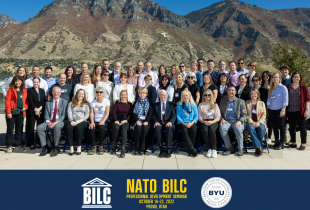
Chinese Language Course Builds Strategic Capabilities for U.S., Allied, Partner Forces
The Partner Language Training Center Europe (PLTCE) at the George C. Marshall European Center for Security Studies launched a new Chinese language course in spring 2025, reflecting a strategic shift in response to evolving global security challenges.
Led by a newly appointed instructor with deep expertise in language education and intercultural communication, the course marks an important milestone for PLTCE’s expanding curriculum. Her arrival highlights PLTCE’s continued commitment to providing high-impact language training for U.S. military personnel, Department of Defense civilians, and NATO partners.
“The decision to introduce Mandarin Chinese was guided by evolving Department of Defense priorities and direct input from our stakeholders,” said Edelmira Nickels, Ph.D., PLTCE director. “As China’s global influence grows—economically, militarily, and in the information domain—the need for linguists proficient in Mandarin has become increasingly urgent.”
The new course is part of PLTCE’s Language Enhancement Courses (LECs), which historically have focused on operationally critical languages such as Russian, Arabic, Persian-Farsi, French, and Ukrainian. The addition of Mandarin Chinese aligns with increased emphasis on the Indo-Pacific region and supports intelligence, operations, and regional engagement initiatives.
PLTCE routinely gathers input through annual forums such as the U.S. Command Language Program Managers workshop and through participation in the Defense Language and National Security Education Office (DLNSEO) events. According to Nickels, those conversations repeatedly underscored a growing demand for Mandarin Chinese proficiency—not only for strategic awareness but for real-time mission support in areas such as intelligence analysis, military communications, and regional deterrence.
“Language training is more than a support function—it’s a strategic asset,” Nickels explained. “A trained linguist in Mandarin might support a European-led task force examining Chinese investments in critical infrastructure, such as ports or telecommunications. That individual could offer real-time translation, decode strategic messaging, and detect red flags in official discourse.”
The Chinese language course at PLTCE is designed not only to build foundational language skills but also to deepen cultural fluency—an essential capability in today’s complex security environment. Students will engage with materials that enhance their ability to navigate cross-cultural communications and understand regional dynamics related to China’s influence.
Mandarin instruction also aligns with the broader mission of the Marshall Center to enhance transatlantic security cooperation and regional deterrence. As Nickels noted, “Language proficiency plays a direct role in rebuilding military readiness and strengthening coordination across allied and partner forces. It enables shared situational awareness and improves mission effectiveness across domains—including cyber, economic security, and information operations.”
Founded in 1984 and integrated into the Marshall Center in the 1990s, PLTCE delivers professional language education to more than 400 students annually. It was designated a NATO Partner Training and Education Centre in 2013, and it continues to serve as a key resource for military language training and testing.
“This new course is a natural extension of our dual mission—to support the U.S. warfighter and provide strategic language capabilities for our allies and partners,” said Nickels. “It reflects our ability to adapt to future challenges and reinforces the long-term value of language as a tool of strategic cooperation.”
----
Partnership Training and Education Centres (PTECs) are a global network of institutions offering courses and academic seminars to both civilian and military staff from NATO and partner countries. Their goal is to improve the professionalism of national personnel, increase international troop interoperability, and conduct education and training activities related to NATO partnership programs and policies. For more information on PTECs and how they enable the U.S. Department of Defense mission and allied and partner nation Defense ministries, visit www.nato.int/cps/en/natohq/topics_187359.htm.

